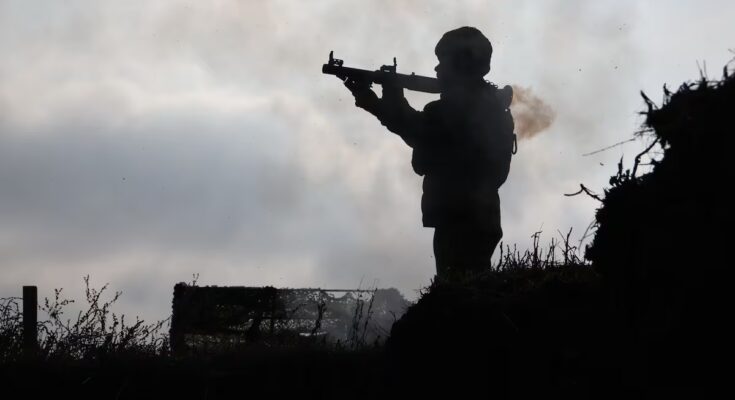Russians and Ukrainians explain, each according to their own version, the bombings, troop movements, assaults on buildings during the urban battle and the advances and setbacks that are occurring in recent days around the disputed city of Pokrovsk (eastern Ukraine). Although the siege of Moscow troops is getting closer and closer – about five kilometers to go until completion – Kiev refuses to consider lost what would be the main square conquered by the Russians in more than two years, since they took Bakhmut in 2023.
If Pokrovsk – and nearby Mirnograd – were to fall, a new door would open to advance towards control of the Donbas region, so desired by Russian President Vladimir Putin, who insists on not accepting a ceasefire with Kiev. With Prokrovsk in Russian hands, the two large centers under Kiev control in the eastern Donetsk region, the cities of Sloviansk and Kramatorsk, would be more exposed. However, the Kremlin’s powerful army has been trying to subjugate this part of Ukraine since 2014 and, more than 11 years later, is still not entirely successful.
To try to save Pokrovsk (which had 60,000 inhabitants before the war) and underline its importance, Ukraine maintains a high military, but also political, deployment around this city. The president, Volodymyr Zelenskyj; His number two, Andri Yermak, and senior army officers, including his top officer, General Oleksandr Sirski, have made visits to the area in recent days.
Kiev’s communications apparatus has made public the images of the meetings and award ceremonies for soldiers at the front by the president, who does not hide that this battle is now his priority. At the same time, there are videos recorded by drones attempting to certify alleged local progress in the streets of Pokrovsk, such as in the town hall, where Ukrainians once again raised the national flag.
But versions also emerge that lead Kiev’s troops to pessimism. The map of the Deep State updated by Ukrainian military analysts thanks to open sources of information shows how the gray zone, in theory terrain not dominated by any of the contenders, precedes the red space of the Russians on the map. “Everything gray in the Deep State city of Pokrovsk should be painted red. About 60% of the city is controlled by the Russians,” a high-ranking officer deployed in the area describes to the media on condition of anonymity. Hromadske. Drone pilots offer similar versions of the same craft with constant changes in position in the face of the enemy advance.
Tactical retreat
Sending Ukrainian special forces among the reinforcements indicates, in principle, that there is no short-term intention to order a tactical withdrawal by Kiev to minimize losses. This would make it possible to build a more rear defensive line capable of stopping the Russians, even if they captured Pokrovsk, as some analysts suggest.
Moscow, for its part, assures that it will keep the area under occupation and in recent days has even announced that the surrender of Ukrainian soldiers is taking place, but there is no trace of any visit by the Kremlin authorities to Pokrovsk and its surroundings. The invading army continues to “destroy the surrounded formations of the Armed Forces of Ukraine”, the Russian Defense Ministry said on Thursday, bringing to 64 the number of buildings that fell under its control between Wednesday and Thursday. They are trying to deliver the final blow with the accumulation of displaced forces from other fronts in Donetsk province, as indicated by the Institute of War Studies (ISW). That brought the ratio to eight Russians for every Ukrainian, according to Zelensky’s calculations a week ago.
In any case, even previous battles fought in Donetsk, such as those of Bakhmut or Avdiivka, took long months to decide, even when their end was already foreseen. With winter on the horizon, surprise advances and massive troop movements become more complicated.
What is hidden behind the Battle of Pokrovsk in which both the Russians and the Ukrainians have engaged in recent weeks? Pokrovsk was the scene of a hundred of the 276 clashes that both sides had on the field in the last 24 hours, the Kiev General Staff reported on Thursday. The dominance on the most contested front of the conflict today suggests military, political and diplomatic motivations.
On the one hand, Russia has not defeated Kiev in a place of this caliber since the fall of Bakhmut in May 2023. In any case, the strategic, logistical and communication value of Pokrovsk is now in question since in the summer of last year the steamroller of war began to devastate this city, in which barely a thousand inhabitants remain. Kiev may be able to hold off the Russian advance here, but if it succeeds, what it will have under its authority is a pile of rubble. The Kremlin, for its part, would see the path more open to finish occupying the 30% of Donetsk province that still belongs to Ukraine.
On the other hand, every city that falls is a new wound in Ukrainian pride and a new step forward in Putin’s attempt to subjugate the entire Donbas, an industrial bastion made up of the Luhansk and Donetsk regions where the war has been ongoing since 2014, when Moscow declared its support for the self-proclaimed separatist republics. For this reason, the two countries hope to be able to achieve victory in this battle at the end of the year and at the beginning of the months in which snow and ice will freeze the battlefield.
Finally, diplomacy also awaits the possible outcome of the Battle of Pokrovsk. Possible peace negotiations, despite the momentum that US President Donald Trump has tried to instill, have stalled. Both contenders seek to demonstrate to their allies their ability to survive or impose their own criteria. Zelenskyj, while not ceasing to ask for new weapons, must demonstrate that his army is capable of continuing to be the necessary containment wall in Eastern Europe and that, in exchange, the country must have the door open to access the European Union and NATO.
Putin, in addition to continuing to cling to a plan of conquest against international legality, intends to demonstrate to Trump – and to the rest of the world – that he is capable of surviving the weight of sanctions and that, with his fait accompli policy, it will be increasingly difficult to force him to return the territory usurped to Kiev.
While trying to take Pokrovsk, their troops do not stop daily bombing the rest of the cities that Ukraine keeps under its control in Donetsk. As EL PAÍS has seen, cities such as Sloviansk, Kramatorsk, Druzhkivka or Konstiantinivka are constant targets of all types of Russian drones, which in winter strike both military and civilian targets, as well as basic energy infrastructure for the population. Apparently, Putin’s strategy is to make the survival of all these cities, some already half-destroyed and almost empty, like Konstiantinivka, as difficult as possible, to undermine Kiev’s morale and pave the way for his army.



